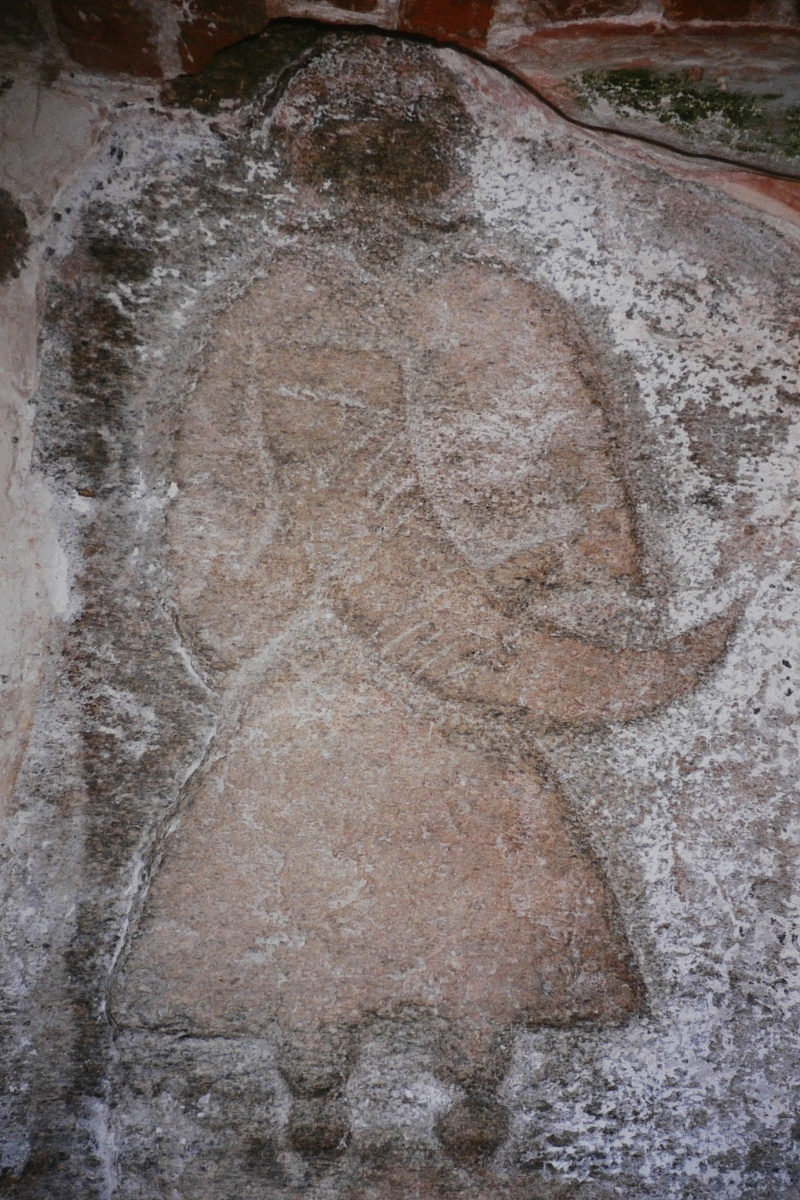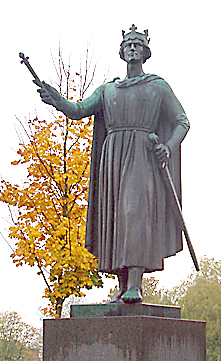|
Rugievit
Rugiaevit, Rugievit () or Ruyevit is a god of the Slavic Rani worshipped on Rügen, mentioned in only two sources: ''Gesta Danorum'' and in '' Knýtlinga saga''. His temple, along with those of Porevit and Porenut, was located in the gord of Charenza, probably today's Garz. The statue of him had seven faces, seven swords at his belt and an eighth one in his hand. Under his lips was a nest of swallows. Mostly associated with the sphere of war, but also sexual. "Private", from the point of view of rulers, cult of Rugiaevit competed with the "public" and theocratic cult of Svetovit of Arkona. Sources The first source to mention Rugiaevit is the ''Gesta Danorum'' by Saxo Grammaticus. Saxo describes when, after Arkona was captured by the Danish king Valdemar I, its inhabitants made an agreement with him, which encourages the inhabitants of Charenza to make a similar agreement and surrender the city without a fight. Saxo describes how the stronghold had three temples dedic ... [...More Info...] [...Related Items...] OR: [Wikipedia] [Google] [Baidu] |
Rani (Slavic Tribe)
The Rani or Rujani (, ''Rujanen'') were a West Slavic tribe based on the island of Rugia (Rügen) and the southwestern mainland across the Strelasund in what is today northeastern Germany. The Rani tribe emerged after the Slavic settlement of the region in the ninth century,Ole Harck, Christian Lübke, Zwischen Reric und Bornhöved: Die Beziehungen zwischen den Dänen und ihren slawischen Nachbarn vom 9. Bis ins 13. Jahrhundert: Beiträge einer internationalen Konferenz, Leipzig, 4.-6. Dezember 1997, Franz Steiner Verlag, 2001, p.15, and ranked among the most powerful of several small Slav tribes between the Elbe and lower Vistula rivers before the thirteenth century. They were among the last tribes to hold to Slavic paganism, and the influence of their religious center at Arkona reached far beyond their tribal borders. In 1168, the Rani were defeated by King Valdemar I of Denmark, and his adviser Absalon, Bishop of Roskilde, resulting in the conversion of the regio ... [...More Info...] [...Related Items...] OR: [Wikipedia] [Google] [Baidu] |
Charenza
Charenza, also Karentia or Karenz, later also Gharense, was a medieval '' Slavic burgwall'' on the island of RĂĽgen in the Baltic Sea. It was the administrative centre of the Rani tribe and of the Principality of Rugia. Today, the remnants are called Venz Castle (). Name The name Charenza (also spelt ''Karentia'' or ''Karenz'') may be derived from an old personal name, ''Chareta'', or from the Rani word for "root", ''Koreta''. In its original form, the name was Korenitsa. Temples Charenza was not only the administrative hub of the Rani tribe, but also a religious centre with the temples of Rugievit, Porevit and Porenut. The main religious centre of the Rani, however, was Arkona on Wittow. Danish conquest In 1168, King Valdemar I of Denmark and his archbishop Absalon captured Arkona. Charenza surrendered a few days later after negotiations with the Rugian princes Tetzlav and Jaromar I. The temples were destroyed, the princes agreed to become Danish vassals and t ... [...More Info...] [...Related Items...] OR: [Wikipedia] [Google] [Baidu] |
Absalon
Absalon (21 March 1201) was a Danish statesman and prelate of the Catholic Church who served as the bishop of Roskilde from 1158 to 1192 and archbishop of Lund from 1178 until his death. He was the foremost politician and church father of Denmark in the second half of the 12th century, and was the closest advisor of King Valdemar I of Denmark. He was a key figure in the Danish policies of territorial expansion in the Baltic Sea, Europeanization in close relationship with the Holy See, and reform in the relation between the Church and the public. He combined the ideals of Gregorian Reform with loyal support of a strong monarchical power. Absalon was born into the powerful '' Hvide'' clan, and owned great land possessions. He endowed several church institutions, most prominently his family's Sorø Abbey. He was granted lands by the crown, and built the first fortification of the city that evolved into modern-day Copenhagen. His titles were passed on to his nephews Anders Sun ... [...More Info...] [...Related Items...] OR: [Wikipedia] [Google] [Baidu] |
Adolf Bastian
Adolf Philipp Wilhelm Bastian (26 June 18262 February 1905) was a 19th-century polymath remembered best for his contributions to the development of ethnography and the development of anthropology as a discipline. His theory of the ''Elementargedanke'' resulted in Carl Jung's development of the theory of ''archetypes''. His ideas influenced the "father of American anthropology" Franz Boas and comparative mythologist Joseph Campbell. Life Bastian was born in Bremen, at the time a state of the German Confederation, into a prosperous bourgeois German family of merchants. His career at university was broad almost to the extent of being eccentric. He studied law at the Ruprecht Karl University of Heidelberg, and biology at what is now Humboldt University of Berlin, the Friedrich Schiller University of Jena, and the University of WĂĽrzburg. It was at this last university that he attended lectures by Rudolf Virchow and developed an interest in what was then known as 'ethnology'. He fi ... [...More Info...] [...Related Items...] OR: [Wikipedia] [Google] [Baidu] |
Valdemar I Of Denmark
Valdemar I Knudsen (14 January 1131 – 12 May 1182), also known as Valdemar the Great (), was King of Denmark from 1154 until his death in 1182. The reign of King Valdemar I saw the rise of Denmark, which reached its medieval zenith under his son King Valdemar II. Childhood Valdemar was the son of Canute Lavard, Duke of Schleswig, the chivalrous and popular eldest son of King Eric I of Denmark. Valdemar's father was murdered by King Magnus I of Sweden days before the birth of Valdemar; his mother, Ingeborg of Kiev, daughter of Grand Prince Mstislav I of Kiev and Christina Ingesdotter of Sweden, named him after her grandfather, Grand Prince Vladimir Monomakh of Kiev. Valdemar was raised at Ringsted in the court of Danish nobleman Hvide#Family of Asser Rig, Asser Rig of Fjenneslev (–1151). Asser was a member of the Hvide noble family and had been raised together with Valdemar's father Canute Lavard. Valdemar was raised together with Asser's sons, including Absalon (–1201), w ... [...More Info...] [...Related Items...] OR: [Wikipedia] [Google] [Baidu] |
Germanic Languages
The Germanic languages are a branch of the Indo-European languages, Indo-European language family spoken natively by a population of about 515 million people mainly in Europe, North America, Oceania, and Southern Africa. The most widely spoken Germanic language, English language, English, is also the world's most List of languages by total number of speakers, widely spoken language with an estimated 2 billion speakers. All Germanic languages are derived from Proto-Germanic language, Proto-Germanic, spoken in Iron Age Scandinavia, History of Germany#Iron Age, Iron Age Northern Germany and along the North Sea and Baltic coasts. The West Germanic languages include the three most widely spoken Germanic languages: English language, English with around 360–400 million native speakers; German language, German, with over 100 million native speakers; and Dutch language, Dutch, with 24 million native speakers. Other West Germanic languages include Afrikaans, an offshoot of Dutch origi ... [...More Info...] [...Related Items...] OR: [Wikipedia] [Google] [Baidu] |
Yarovit
Yarovit, Iarovit (or Yerovit, Ierovit) is a Polabian god of war, worshipped in Vologošč ( Circipanians) and Hobolin ( Hobolians; modern Havelberg). Sources give only a brief description of his cult, his main temple was located in Vologošč, where there was a golden shield belonging to Yarovit. By one Christian monk he was identified with the Roman Mars. Etymology In Latin records, this theonym is noted as and . These notations should be read as ''Yarovit'', since in Latin German texts the Slavic element ''jar-'' is sometimes written as ⟨ger-⟩ or ⟨her-⟩ ( = Slavic ''Jarišov'', = Slavic ''Jeruš'', = Slavic ''Jarogněv'' etc.). The notation by ⟨h⟩ is the result of changing the grapheme ⟨g⟩ → ⟨gh⟩ → ⟨h⟩ due to matching Polish pronunciation with German writing. The Old Polabian form is reconstructed as ''*Jerovit''. Scholars connect the root ''jar-'' with the Proto-Slavic adjective ''*jarъ(jь)'' "vigorous, strong" ( dated "vigorous", "imp ... [...More Info...] [...Related Items...] OR: [Wikipedia] [Google] [Baidu] |
Lubor Niederle
Lubor Niederle (September 20, 1865 – June 14, 1944) was a Czechs, Czech archeologist, anthropologist and ethnographer. He is seen as one of the founders of modern archeology in Czech lands. He was born in Klatovy. He studied at the Charles University in Prague from 1883 to 1887. He was initially interested in classical archaeology, then studied anthropology, sociology and ethnology. Later, he studied in Munich under professor Johannes Rank (1889) and in Paris under professor LĂ©once Manouvriere at the École d’anthropologie. Niederle also travelled in several Slavic countries, studying archaeological findings and historical documents. In 1898 Niederle was named professor at the Charles University. As archaeologist he had represented the "university school" (''univerzitnà škola''), opposed to the "museum school" (''muzejnà škola'') represented by archaeologist Josef Ladislav PĂÄŤ. During 1907–08 Niederle served as a Dean (education), dean of Faculty of Philosophy, durin ... [...More Info...] [...Related Items...] OR: [Wikipedia] [Google] [Baidu] |
Serbo-Croatian
Serbo-Croatian ( / ), also known as Bosnian-Croatian-Montenegrin-Serbian (BCMS), is a South Slavic language and the primary language of Serbia, Croatia, Bosnia and Herzegovina, and Montenegro. It is a pluricentric language with four mutually intelligible Standard language, standard varieties, namely Serbian language, Serbian, Croatian language, Croatian, Bosnian language, Bosnian, and Montenegrin language, Montenegrin. South Slavic languages historically formed a dialect continuum. The region's turbulent history, particularly due to the expansion of the Ottoman Empire, led to a complex dialectal and religious mosaic. Due to population migrations, Shtokavian became the most widespread supradialect in the western Balkans, encroaching westward into the area previously dominated by Chakavian and Kajkavian. Bosniaks, Croats, and Serbs differ in religion and were historically often part of different cultural spheres, although large portions of these populations lived side by side und ... [...More Info...] [...Related Items...] OR: [Wikipedia] [Google] [Baidu] |
Bulgarian Language
Bulgarian (; , ) is an Eastern South Slavic, Eastern South Slavic language spoken in Southeast Europe, primarily in Bulgaria. It is the language of the Bulgarians. Along with the closely related Macedonian language (collectively forming the East South Slavic languages), it is a member of the Balkan sprachbund and South Slavic languages, South Slavic dialect continuum of the Indo-European language family. The two languages have several characteristics that set them apart from all other Slavic languages, including the elimination of grammatical case, case declension, the development of a suffixed definite article, and the lack of a verb infinitive. They retain and have further developed the Proto-Slavic language, Proto-Slavic verb system (albeit analytically). One such major development is the innovation of evidentiality, evidential verb forms to encode for the source of information: witnessed, inferred, or reported. It is the official Languages of Bulgaria, language of Bulgar ... [...More Info...] [...Related Items...] OR: [Wikipedia] [Google] [Baidu] |
Czech Language
Czech ( ; ), historically known as Bohemian ( ; ), is a West Slavic language of the Czech–Slovak group, written in Latin script. Spoken by over 12 million people including second language speakers, it serves as the official language of the Czech Republic. Czech is closely related to Slovak, to the point of high mutual intelligibility, as well as to Polish to a lesser degree. Czech is a fusional language with a rich system of morphology and relatively flexible word order. Its vocabulary has been extensively influenced by Latin and German. The Czech–Slovak group developed within West Slavic in the high medieval period, and the standardization of Czech and Slovak within the Czech–Slovak dialect continuum emerged in the early modern period. In the later 18th to mid-19th century, the modern written standard became codified in the context of the Czech National Revival. The most widely spoken non-standard variety, known as Common Czech, is based on the vernacular of ... [...More Info...] [...Related Items...] OR: [Wikipedia] [Google] [Baidu] |




